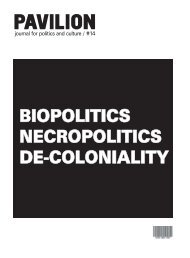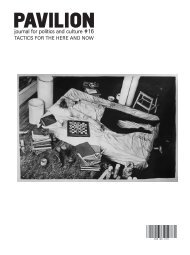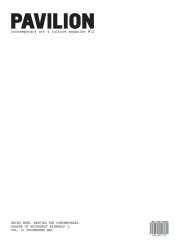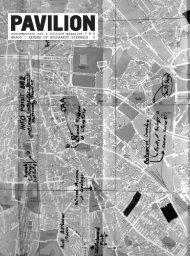PAVILION
PAVILION
PAVILION
- No tags were found...
Create successful ePaper yourself
Turn your PDF publications into a flip-book with our unique Google optimized e-Paper software.
frontier to frontier, from periphery to<br />
periphery, from squat to squat, the line of<br />
transmigration is always tangled with<br />
detours. Deligny has proposed a particular<br />
way of mapping the daily courses of<br />
the autistic children. His cartography<br />
traces customary lines and supple lines,<br />
where the child makes a curl, finds something,<br />
slaps his hands, hums a tune,<br />
retraces his steps, and then makes<br />
meandering lines, lignes d’erre<br />
‘... a chevêtre [an ‘entangled curl’ ] is<br />
similar to a detour as long as the need<br />
for, the cause of this detour escapes<br />
our knowledge. The term “chevêtre”<br />
indicates that there is something<br />
there that attracts a profusion of<br />
lignes d'erre ’. 8<br />
If a map of European mobility were to be<br />
made, it would be criss-crossed with<br />
meandering lines which make detours<br />
and deviations from one country to the<br />
next, looking for that ‘something that<br />
attracts’. This map would include lines of<br />
migration: entangled customary lines,<br />
supple lines and curls indicating other<br />
kinds of social behaviour, other economic<br />
and political opportunities than the<br />
‘straight’. The ‘lines of flight’ would be an<br />
important feature of such a map. Deleuze<br />
defines the ‘line of flight’ not only as a<br />
simple line, but as a force that maintains<br />
a tangle of lines:<br />
(...) There is a third type of line,<br />
stranger still, as thought something<br />
were carrying us away, through our<br />
segments but also across our thresholds,<br />
towards an unknown destination,<br />
neither pre-existent nor foreseeable.<br />
9<br />
‘I came here by flight ’- says a migrant,<br />
referring to the illegal way he crossed<br />
over the frontiers of several countries in<br />
his way to France. ‘And I will return by the<br />
“sending off”‘, which in French immigration<br />
legislation means a plane ticket with<br />
financial assistance of about 1000 FF<br />
(150€) for reinstatement in the home<br />
country. A new kind of logic recalculates<br />
this ‘sending off’, this ‘going back home’,<br />
as the real purpose of initial departure.<br />
Nothing happens other than a detour, a<br />
curl, a delay, and a subsidy. This ‘curling’<br />
logic transforms impedimenta into pathways,<br />
obstacles into objectives, conflicts<br />
into alliances, policies of rejection into<br />
politics of welcoming. It transforms a ‘bad<br />
end’ into a ‘happy end’. The faux<br />
migrants’ main objective is to make profit<br />
from a ‘line of flight’. They have invented<br />
a new market product that is the migration<br />
itself, the double crossing of a frontier,<br />
the transversion, a movement by<br />
detour, the pure displacement of a person<br />
from a country to another and back<br />
again.<br />
Analogies and diagrams of life<br />
The politics which negotiate entangled<br />
‘lines’ must stick to a diagram. For the<br />
destiny of an individual or a group, the<br />
diagram is the profitable ‘passage<br />
through catastrophe’. Deleuze talks<br />
about ‘diagram’ in the context of Francis<br />
Bacon's painting and notices that ‘the<br />
diagram is a chaos, a catastrophe, but<br />
also a germ of order or rhythm’. For faux<br />
migrants, ‘losing everything’, ‘leaving it all<br />
behind’ is not a tragedy but a trick.<br />
Playing as if all is lost is therefore putting<br />
oneself in a state of diagram, in a ‘state of<br />
factual possibility’, as Deleuze says. It<br />
transforms the ‘impossible’ into a ‘state of<br />
possibility’. ‘How did you get here?’ The<br />
migrant replies mockingly: ‘I've walked<br />
across the garden’. In this logic, the garden<br />
of the family house extends topologically<br />
as far as Paris, just as ‘the mouth’<br />
in some of Bacon’s portraits goes from<br />
one edge of the face to the other.<br />
According to Deleuze,<br />
‘The diagram is therefore the operative<br />
totality of insignificant and nonrepresentative,<br />
lines and zones, traits<br />
and spots’. 10<br />
A community is not made up exclusively<br />
of ‘individual lines’ but integrates equally<br />
‘insignificant and non representative’<br />
zones, lines and spots of places and<br />
things with which individuals co-habit and<br />
operate diagrammatically in the practice<br />
of migration. Deleuze has observed that<br />
the language of the diagram is analogical:<br />
‘It is the notion of modulation (and not<br />
that of sameness) that is generally apt to<br />
make us understand the nature of the<br />
analogical language or the diagram.<br />
‘Modulation’, which functions in the analogical<br />
synthesizers as an addition of<br />
‘intensive subtractions’.<br />
The notions of ‘subtraction’ and ‘intensity’<br />
can be associated with migration.<br />
Migration functions as a modulator for the<br />
social field. The migrants respect codes<br />
and conventions as long as they can be<br />
modulated. They make their own ‘intensive<br />
subtractions’ and transport them<br />
somewhere else. They practise a ‘relational’<br />
way of doing within a ‘conventional’<br />
thought structure. But for the migrant,<br />
the analogy is not simply a way of doing<br />
but also a policy which is enacted from<br />
thing to thing, person to person, situation<br />
to situation. A policy based on analogy is<br />
more precise, clearer, more adequate to<br />
the practice of migration than a policy<br />
ruled by codes and norms. Know hows,<br />
tricks and lucky finds are linked by proximity.<br />
Analogical thought works by correspondence<br />
not by comparison. As imaginative<br />
insight, it recognises something<br />
familiar in the alien and unfamiliar. The<br />
migrant reading of the alien cityscape<br />
keeps the familiar at hand. The<br />
Romanians migrants that squat abandoned<br />
houses near La Defense (the main<br />
business district in Paris), call Grande<br />
Arche, ‘the great granary’. The biggest<br />
square in the district is called ‘the vague<br />
field’ -the place where they cross paths<br />
with tourists and functionaries in high<br />
finances during the week and play football<br />
on Sundays. This particular way of<br />
naming places shows how the hostile<br />
environment of a financial metropolis can<br />
be compressed reduced to the size of a<br />
village.<br />
The home environment is kept in everyday<br />
language in the same way that personal<br />
belongings are kept in plastic bags<br />
in the squat. Living out of plastic bags is<br />
a way of living in the metropolis while<br />
resisting it. The configuration of the<br />
native village, the order of streets and<br />
houses are topologically compressed<br />
within the squat. Neighborhoods and<br />
familial relations regulate the occupation<br />
of rooms. Boundaries transported from<br />
home with their existing customs modulate<br />
the intimate conditions within the<br />
promiscuity of the squat. The intimate,<br />
the private and the collective are kept<br />
separate and allowed to cross each other<br />
through discrete boundaries. As a<br />
[92]<br />
[93]








